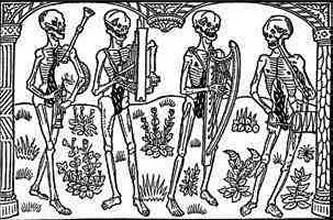 The Bone Minstrels.
The Bone Minstrels.Frequency: Very rare
No. appearing: 4-8
Armor class: 7
Move: 12"
Hit dice: 1
% in lair: 100%
Treasure type: special
No. of attacks: 1
Damage/attack: 1d6
Special attacks: transfixing reel, (see below)
Special defenses: defended by their "audience"
Magic resistance: standard
Intelligence: non
Alignment: neutral
Size: M
Psionic ability: nil
Bone Minstrels are a special type of undead, the blame for which, is widely laid at the tapping feet of Wyrdlbrr the Composarch, necromant and music aficionado. Bone minstrels appear to be the same as any skeleton-type undead, save that, instead of swords or spears, they bear a variety of musical instruments.
In the same manner that standard skeletons are employed as warders, Bone Minstrels are tasked to guard a room, or other specified area, and act when intruded upon.
As soon as trespassers transgress against the warded space, the bone minstrels will at once, rise from their stools and begin to play their instruments. The tune which they play is the dread transfixing reel. All who hear the music must save vs charm, or immediately begin to dance with reckless abandon to the eerie, wailing song.
So long as the bone minstrels play, the charmed will continue to dance. As the undead never tire, the victims will dance to their deaths, if they are not stopped.
The bone minstrels must all be destroyed in order to halt the dance. Each time a minstrel is destroyed, the charmed are allowed to attempt to save vs the transfixing reel.
A minstrel will not defend itself unless it's instrument is broken. Instead, the minstrels are protected by their skeletal audience. The audience is composed of the remains of past victims of the bone minstrels. There will be 1d10 audience skeletons, armed with various weapons. These will rise from the floor as soon as the bone minstrels begin to play. They will either dance along with the charmed victims of the minstrel's reel, or defend the minstrels from any who attack them.
The Bone Minstrels otherwise are treated as standard skeletons. They take only half damage from edged weapons, are immune to Sleep, Charm, Hold, or cold-based magics, and take full damage from fire. Holy water causes 2-8 points of damage for each vial which strikes a bone minstrel.
There is a 20% chance that any encountered group of Bone Minstrels will include a, "Vocalist".
If a vocalist is present, then the chance to save vs charm and avoid the transfixing reel incurs a -2 penalty.
This is perhaps the best Undead creature-type I have read. Period.
ReplyDelete--Great work! :D
I really did this E.G. - cause I've worked California Ren Faires for decades, and there has always been a bone band marching around Faire. My group even had a hooch right next to them at Northern Faire long ago. They are awesome to stumble across in the street when you are drunk out of your mind.
ReplyDeleteGreat take on them. I never thought of statting them out.
OH, p.s. E.G. - that classic etching has some history with my group (Morris Dancers and Musicians). My best friend has that skeleton drummer tatooed on his leg, and for a couple of years I have been considering getting that skeleton bagpiper (cause I play the pipes, 'natch).
ReplyDeleteThanks, Timeshadows and Brunomac! Glad you like them. I ran into that illustration when I was looking for plague doctor pics for the Fool Hammers post. I though, man, I gotta use that for something. I always though non-thinking undead ought to be variable to some degree. I never want the players to get complacent.
ReplyDeleteI used to go to renn faires all the time, but it's been a while since there was one in easy striking distance. It's probably been ten years now.
Fantastic stuff indeed! Skeletons are probably my favorite undead, and I love the Medieval/Renaissance feel of these guys. :D
ReplyDeleteVery cool undead - reminds me of some of the plague-related illustrations of the Middle Ages.
ReplyDelete